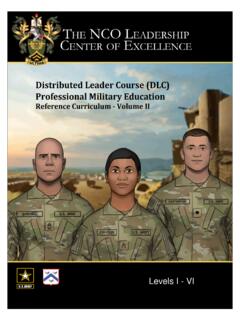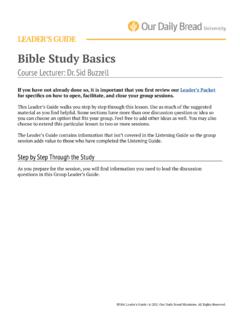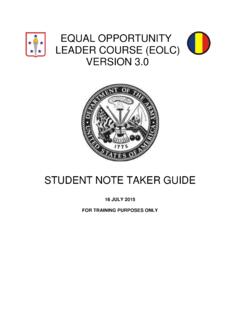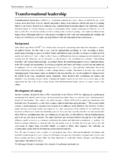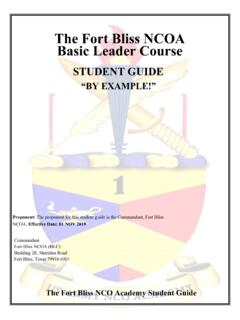Transcription of Leadership Overview - Columbus State University
1 117 Journal of Business Studies Quarterly 2014, Volume 5, Number 4 ISSN 2152-1034 Situational, Transformational, and Transactional Leadership and Leadership Development Jim Allen McCleskey Abstract In order to advance our knowledge of Leadership , it is necessary to understand where the study of Leadership has been. McCleskey (2014) argued that the study of Leadership spans more than 100 years. This manuscript describes three seminal Leadership theories and their development. Analysis of a sampling of recent articles in each theory is included. The manuscript also discusses the concept of Leadership development in light of those three seminal theories and offers suggestions for moving forward both the academic study of Leadership and the practical application of research findings on the field.
2 Keywords: Leadership , Situational Leadership , Transactional Leadership , Transformational Leadership , Development, Review Introduction This manuscript analyzes three seminal Leadership theories: situational Leadership , transformational Leadership (TL), and transactional Leadership . It begins with introductory comments about the academic field of Leadership , continues with a look at the three theories including their history and development, and proceeds to a micro-level, examining several recent published studies in each area. It presents a comparison and contrast of the key principles of each. The manuscript also discusses modern Leadership challenges and Leadership development in the context of all three theories. First, a brief history of Leadership follows. Leadership Theory One of the earliest studies of Leadership , Galton s (1869) Hereditary Genius emphasized a basic concept that informed popular ideas about Leadership (Zaccaro, 2007).
3 The idea is that Leadership is a characteristic ability of extraordinary individuals. This conception of Leadership , known as the great man theory, evolved into the study of Leadership traits, only to be supplanted later the theories under discussion here (Glynn & DeJordy, 2010). Before discussing Leadership , it is useful to define the term. The question of the correct definition of Leadership is a nontrivial matter. Rost (1993) discovered 221 different definitions and conceptions of Leadership . Some of those definitions were narrow while others offered broader conceptions. Bass (2000; 2008) argued that the search for a single definition of Leadership was pointless. Among multiple 118 definitions and conceptions, the correct definition of Leadership depends on the specific aspect of Leadership of interest to the individual (Bass, 2008).
4 This manuscript focuses on three specific conceptions of Leadership : situational, transformational, and TL. The next section begins with situational Leadership . Situational Leadership Situational Leadership theory proposes that effective Leadership requires a rational understanding of the situation and an appropriate response, rather than a charismatic leader with a large group of dedicated followers (Graeff, 1997; Grint, 2011). Situational Leadership in general and Situational Leadership Theory (SLT) in particular evolved from a task-oriented versus people-oriented Leadership continuum (Bass, 2008; Conger, 2010; Graeff, 1997; Lorsch, 2010). The continuum represented the extent that the leader focuses on the required tasks or focuses on their relations with their followers.
5 Originally developed by Hershey and Blanchard (1969; 1979; 1996), SLT described Leadership style, and stressed the need to relate the leader s style to the maturity level of the followers. Task-oriented leaders define the roles for followers, give definite instructions, create organizational patterns, and establish formal communication channels (Bass, 2008; Hersey & Blanchard, 1969; 1979; 1996; 1980; 1981). In contrast, relation-oriented leaders practice concern for others, attempt to reduce emotional conflicts, seek harmonious relations, and regulate equal participation (Bass, 2008; Hersey & Blanchard, 1969; 1979; 1996; 1980; 1981; Shin, Heath, & Lee, 2011). Various authors have classified SLT as a behavioral theory (Bass, 2008) or a contingency theory (Yukl, 2011). Both conceptions contain some validity.
6 SLT focuses on leaders behaviors as either task or people focused. This supports its inclusion as a behavioral approach to Leadership , similar to the Leadership styles approach (autocratic, democratic, and laissez-faire), the Michigan production-oriented versus employee-oriented approach, the Ohio State initiation versus consideration dichotomy, and the directive versus participative approach (Bass, 2008; Glynn & DeJordy, 2010). It also portrays effective Leadership as contingent on follower maturity. This fits with other contingency-based Leadership theories including Fiedler s contingency theory, path-goal theory, Leadership substitutes theory, and Vroom s normative contingency model (Glynn & DeJordy, 2010; Bass, 2008; Yukl, 2011). Both conceptualizations of SLT admit that task-oriented and relation-oriented behaviors are dependent, rather than mutually exclusive approaches.
7 The effective leader engages in a mix of task and relation behaviors (Cubero, 2007; Graeff, 1997; Shin et al., 2011; Yukl, 2008; 2011; Yukl & Mahsud, 2010). The level of maturity (both job and psychological maturity) of followers determines the correct Leadership style and relates to previous education and training interventions (Bass, 2008; Hersey & Blanchard, 1969). Some scholars criticize SLT specifically and situational Leadership in general. Criticisms of situational Leadership SLT was a popular conception of Leadership ; however, as experience with the original Hersey & Blanchard model accrued, problems with the construct appeared. Nicholls (1985) described three flaws with SLT dealing with its consistency, continuity, and conformity. Bass (2008) agreed, noting lack of internal consistency, conceptual contradictions, and ambiguities.
8 Other scholars suggested additional weaknesses of SLT (Bass, 2008; Glynn & DeJordy, 2010). Research revealed that no particular Leadership style was universally effective and behavioral theories relied on abstract Leadership types that were difficult to identify (Glynn & DeJordy, 2010). A number of recent studies utilized the situational Leadership approach. Next, this manuscript describes two of them. 119 Research articles on situational Leadership Paul and Elder (2008) presented a guide for the analysis of research articles. Paul and Elder (2008) suggested that the examination of an article explicitly consider the purpose, question, information, concepts, assumptions, inferences, point of view, and implications in the study. Arvidsson, Johansson, Ek, and Akselsson (2007), used a situational Leadership framework in the study of air traffic control employees.
9 Arvidsson et al. (2007) set out to investigate how Leadership styles and adaptability differ across various situations, conditions, structures, and tasks in the air traffic control arena. The authors asked a variety of research questions about the relationship between Leadership adaptability, task-orientation of the leader, Leadership style, working situation, operational conditions, organizational structure, and level of Leadership experience (Arvidsson et al., 2007). The information contained in the article included a discussion of the literature linking Leadership and safety and a relationship between Leadership and reduced stress levels. The article described the SLT model, the study, methods, results, and discussion. The specific concepts presented included Leadership and SLT.
10 The authors implicit assumptions included a relationship between effective Leadership and workplace safety as well as a relationship between Leadership effectiveness and stress and between stress and poor workplace performance. The authors also assumed that differences among coworkers require leaders to exhibit sensitivity to and the ability to diagnose varying levels of maturity or readiness among employees (Arvidsson et al, 2007). The point of view of the article is quantitative, positivist, and objectivist. The authors hypothesize a correlation between independent and dependent variables and then set out to investigate and confirm that relationship (Creswell, 2009). Arvidsson et al. (2007) discussed implications of their work. In particular, despite the fact that previous research indicated that relation-oriented Leadership is preferred over task-oriented Leadership , task-orientation is suitable in some situations.
